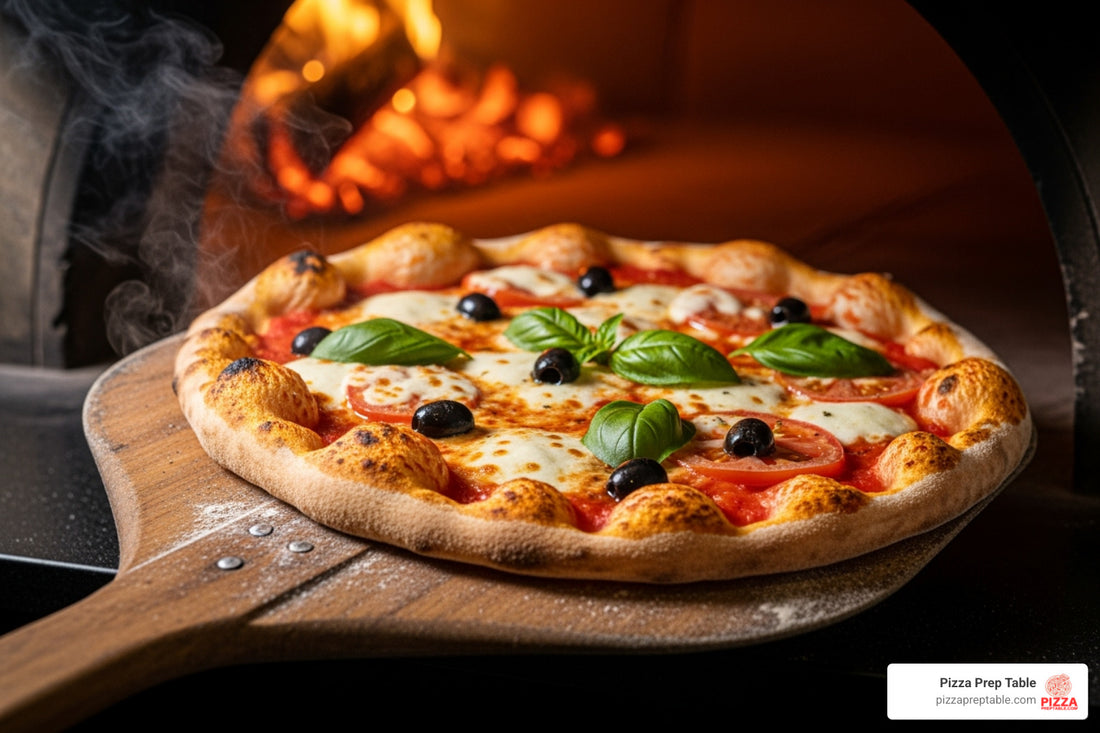
From Dough to Oven: The Art of the Pizza Peel
Share
Why Every Pizzeria Needs to Master Pizza Peel Use
Pizza peel use is the essential skill that separates perfect pies from kitchen disasters. A pizza peel is a flat paddle with a long handle that lets you safely transfer pizzas into and out of hot ovens. Without one, you risk burns, spilled toppings, and mangled pizzas. Whether you're using a baking stone, steel, or a commercial deck oven, the peel is your key to a perfect launch.
Many first-time pizzeria owners face the dreaded failed pizza launch—that moment when a carefully crafted pie sticks, slides, or crumples. The good news: pizza peel use is a learnable skill. With the right equipment and technique, you'll be launching pizzas like a pro.
I'm Sean Kearney, and after years of helping restaurant owners outfit their kitchens, I've seen how proper pizza peel use transforms both workflow and pizza quality. The right tools, and knowing how to use them, make all the difference in a busy commercial kitchen.
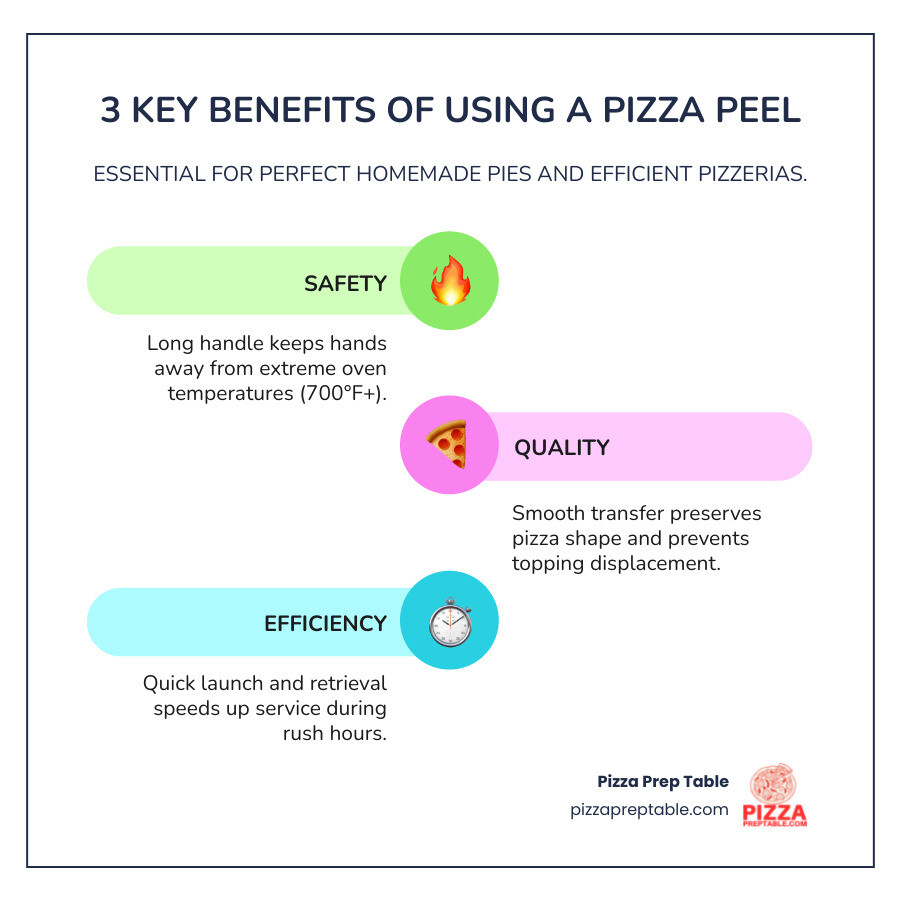
Choosing Your Weapon: A Guide to Pizza Peel Types
The secret to mastering pizza peel use starts with choosing the right tool for the job.
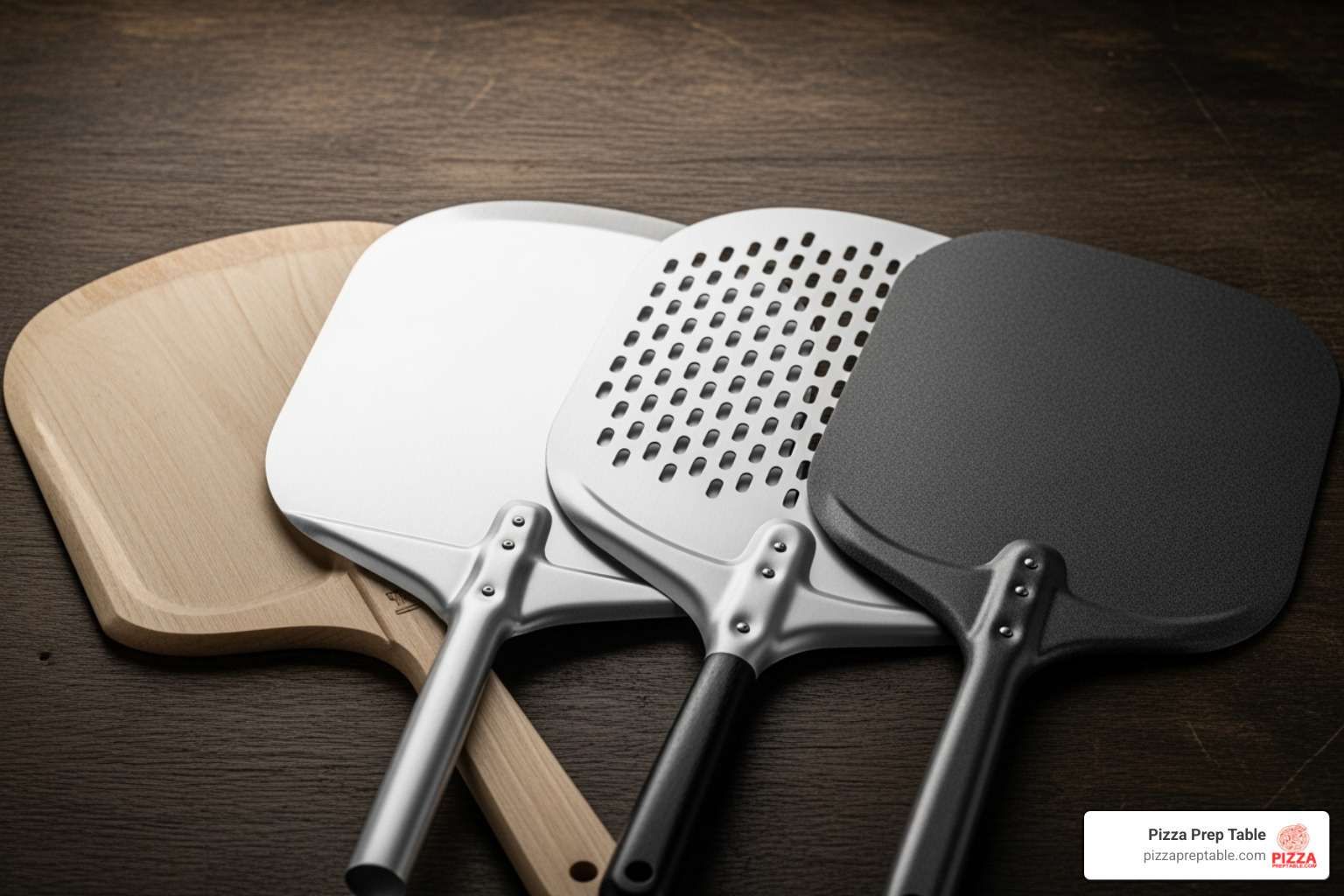
Before diving into materials, consider the physical characteristics. Handle length is crucial for safety; deep commercial ovens require long handles, while shorter handles are easier to control in home ovens. Peel shape is typically rectangular for versatility, though round peels are useful for rotating pizzas. Peel size should match your pizza and oven opening—a peel that's too small won't support the pizza, and one that's too large won't fit in the oven.
Here's how the main types of peels stack up against each other:
| Peel Type | Stickiness | Maintenance | Durability | Best Use |
|---|---|---|---|---|
| Wood/Bamboo | Low (nonstick) | Hand wash, air dry, occasional oiling | Moderate | Launching, especially for beginners or moist doughs |
| Metal (Solid) | Moderate to High | Easy to clean, dishwasher safe | High | Retrieving, turning, experienced users, commercial settings |
| Metal (Perforated) | Low to Moderate | Easy to clean, dishwasher safe | High | Launching (allows flour to fall through), turning, retrieving |
| Composite | Low (nonstick) | Hand wash, often dishwasher safe | High | All-purpose, launching, turning, retrieving, serving, slicing |
Wood and Bamboo Peels: The Traditional Choice
Wood peels are forgiving for beginners. Their porous grain naturally holds flour and absorbs surface moisture from the dough, preventing sticking. This makes them ideal for launching pizzas, especially wetter doughs. Their thickness provides stability but can be clumsy for retrieving a cooked pizza. Wood peels require care: hand wash only, dry thoroughly, and oil every few months to prevent warping or cracking.
If you're interested in beautiful wooden options that double as serving platters, check out this guide with more info about acacia pizza peels.
Metal Peels (Aluminum & Steel): The Professional's Tool
Professionals favor metal peels for their thinness and durability. The razor-thin edge slides easily under pizzas for launching, turning, and retrieving, which is critical for efficiency in a busy kitchen. Metal peels are tough and easy to clean, with many being dishwasher safe. The main drawback is a higher sticking risk, as metal doesn't absorb moisture. This requires more skill and a confident technique. For retrieving and turning pizzas, a thin metal peel is best.
Perforated peels are a popular upgrade. The holes allow excess flour to fall through, reducing burning and smoke on your baking surface. They combine the thinness of metal with better non-stick properties.
Composite Peels: The Modern Hybrid
Made from paper composite materials, these peels offer the best of both worlds. Brands like Epicurean have pioneered peels that are thin like metal but non-stick like wood. They are incredibly durable, won't warp or crack, and are often dishwasher safe. Their thin profile is great for both launching and retrieving. Composite peels are true all-purpose tools: you can launch, turn, retrieve, slice, and serve on the same surface. While they may cost more upfront, their versatility and longevity make them a worthwhile investment.
While you're exploring different pizza-making materials and tools, you might find helpful insights in this article about unlocking the secrets of your aluminium pizza pan for the ultimate homemade pie.
The Prep Work: How to Prevent a Sticky Situation
The truth about pizza peel use is that a sticky launch is heartbreaking but preventable. The enemy is moisture. When wet dough sits on a peel, it creates a bond. This moisture can come from high-hydration dough, sauce drips, or wet toppings. The longer the pizza sits, the stickier it gets. The solution is to work fast.
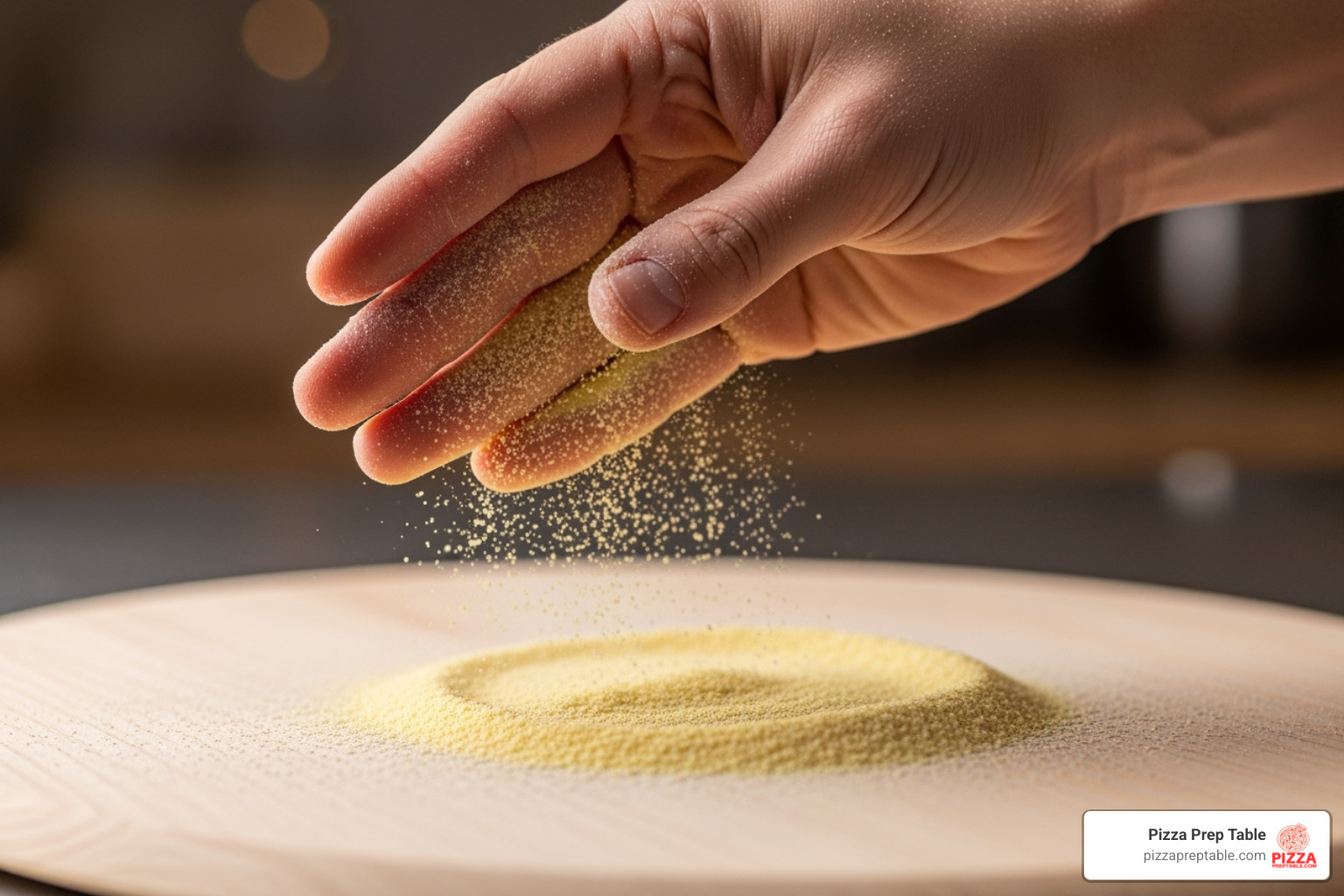
The Great Dusting Debate: Flour, Cornmeal, or Semolina?
Professionals who've launched thousands of pizzas tend to reach for one thing: semolina. It's a coarse flour that acts like tiny ball bearings under your dough, preventing it from sticking. Unlike regular flour, semolina doesn't absorb water quickly, and it doesn't burn as easily as cornmeal on a hot baking surface. If you're stocking up, semolina flour is a top choice for pizzaiolos.
Cornmeal also works, adding a pleasant crunch, but it can burn and taste bitter at high temperatures. Regular flour is a common beginner's choice, but it absorbs water and becomes sticky fast. If you use it, you must work at lightning speed. Our recommendation is simple: invest in a bag of semolina and use it generously.
The Parchment Paper Method: A Foolproof Alternative?
If the thought of launching a pizza makes you sweat, parchment paper is your friend. You build the pizza on a sheet of parchment placed on your peel, then slide the whole thing into the oven. It's a stress-free launch that eliminates the risk of sticking.
The main limitation is temperature. Most parchment is rated for temperatures below 500 b0F, making it unsuitable for high-heat Neapolitan-style cooking. It can also prevent the direct contact needed for the crispiest crust. For home ovens under 500 b0F, it's a great method. But for authentic pizzeria crusts, you'll need to master the traditional dusting technique. For more guidance on building your pizza-making skills, check out how to prep pizza like a pro.
Mastering the Launch: A Step-by-Step Guide to Pizza Peel Use
This is the moment of truth. Successfully launching a pizza from the peel into a scorching oven is a skill that combines preparation, technique, and confidence. The entire process hinges on a smooth, swift motion. Hesitation is your enemy.
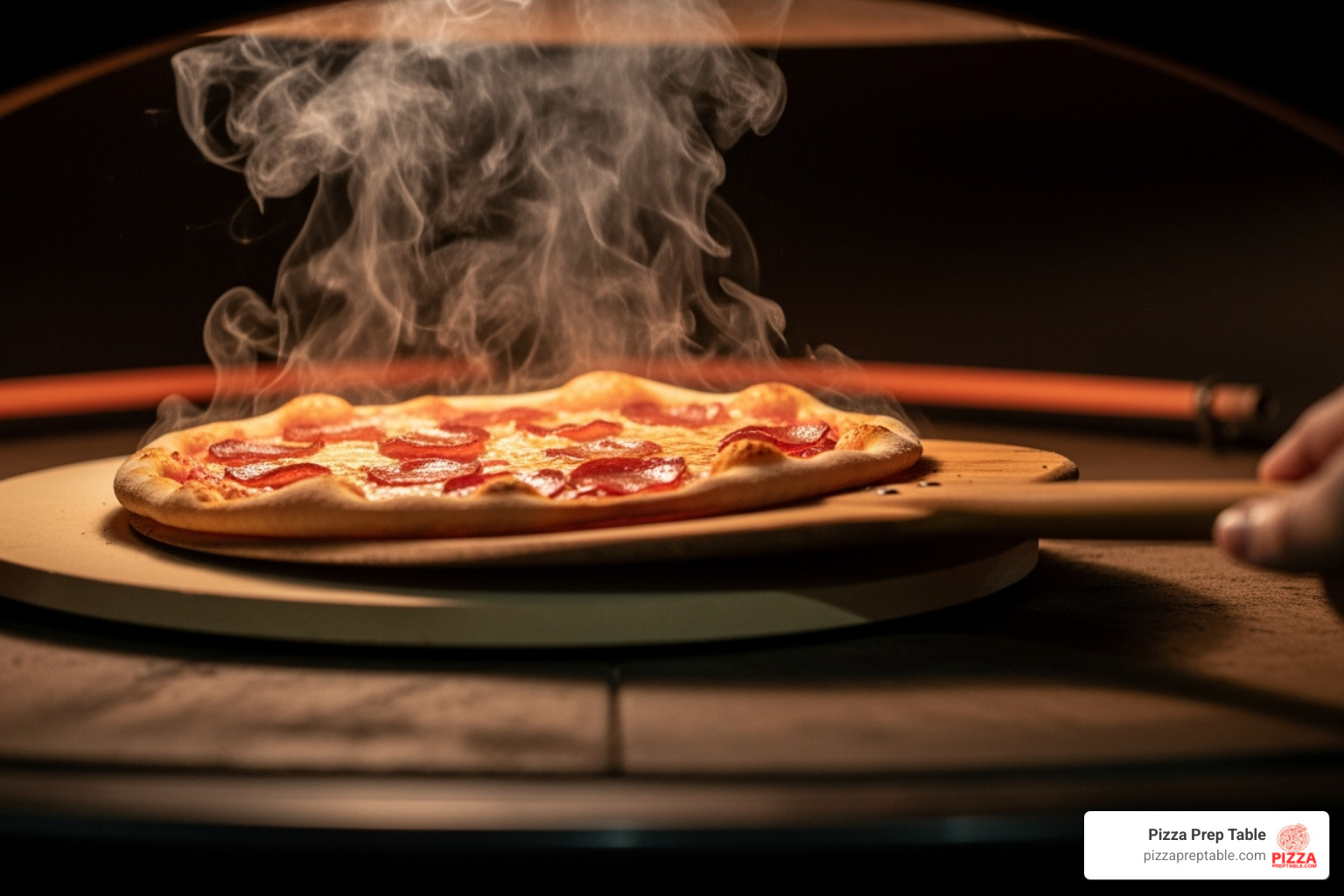
Step-by-Step Pizza Launch
- Dust the peel: Thoroughly dust your clean, dry peel with an even layer of semolina.
- Place the dough: Gently lay your stretched dough onto the center of the peel.
- Top quickly: Add your sauce and toppings. The longer the dough sits, the more it will stick. Avoid spilling sauce on the peel.
- The 'jiggle' test: This is the most crucial step in pizza peel use. Give the peel a gentle, short forward-and-backward shake. The pizza should slide freely. If it doesn't, lift the stuck spots with a spatula, sprinkle more semolina underneath, and test again. Never proceed if the pizza is stuck.
- Launch: Open your oven and position the tip of the peel where you want the back of the pizza to land. At a slight downward angle, use a quick-snap motion: pull the peel back towards you in one fluid movement. The pizza should slide off onto the hot surface. Close the oven door immediately.
Key Techniques for Successful Pizza Peel Use
The 'jiggle' or shimmy is your best friend. It's a quick check that confirms your pizza is free before you launch. Practice the motion with a folded dish towel on a cool counter to build muscle memory without the pressure. Also, avoid overloading your pizza with toppings, as excess weight makes it prone to sticking and can lead to a soggy crust.
Advanced Pizza Peel Use: Turning and Retrieving
Your work isn't over once the pizza is in the oven. In high-temperature ovens, one side often cooks faster. A small, round turning peel is invaluable for rotating the pizza without removing it, ensuring an even bake. If you don't have one, a thin metal peel works too. Regular rotation is key to a perfectly browned crust.
Once baked, retrieve the pizza with a thin metal peel. Its thin blade slides firmly under the crisp crust without damaging it. Lift it out in one smooth motion. After retrieving your masterpiece, you'll want to master mastering the slice pizza cutter techniques for your pizza stone to serve it perfectly.
Maintenance, Mistakes, and Alternatives
Mastering pizza peel use includes caring for your tools and learning from common errors.
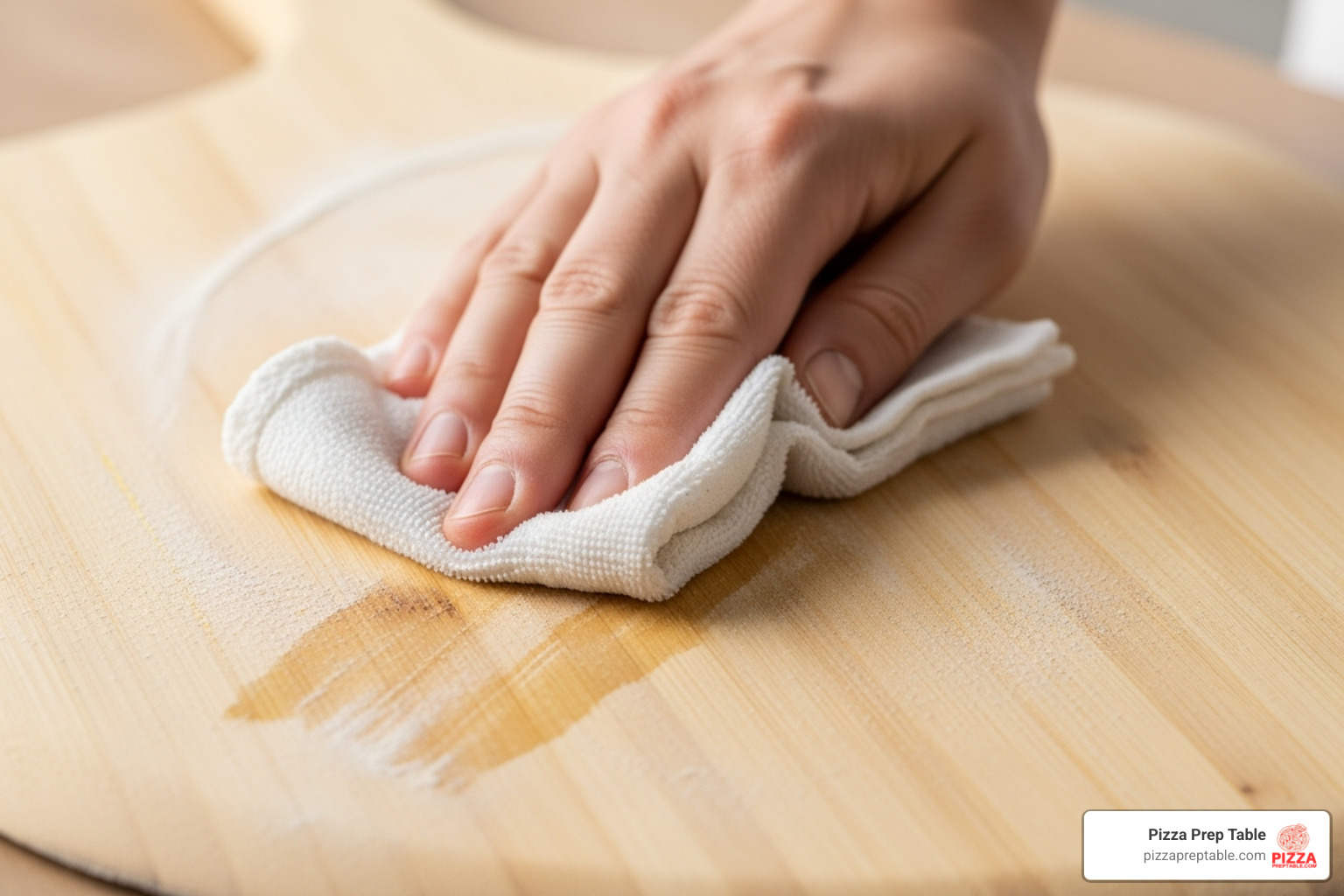
Cleaning and Maintaining Your Pizza Peel
A well-maintained peel performs better and lasts longer.
- Wood Peels: Wipe clean with a damp cloth. Avoid soaking. Never use a dishwasher. Air dry completely. To prevent drying and cracking, re-oil every 4-6 months with food-grade mineral oil.
- Metal Peels: These workhorses are easy to clean with soap and hot water. Most are dishwasher safe.
- Composite Peels: Many are dishwasher safe, offering the easiest maintenance. Always check the manufacturer's instructions.
Proper storage in a dry place is also important to prevent damage.
Common Mistakes to Avoid
- Overloading with toppings: Too much weight makes the dough heavy, prone to sticking, and can result in a soggy crust.
- Letting dough sit too long: Work quickly. The longer raw dough sits on the peel, the more it adheres.
- Using a wet peel: Ensure your peel is bone dry before dusting. Moisture is like glue.
- Launching a stuck pizza: If the pizza fails the 'jiggle' test, stop. Fix the stuck spots before attempting to launch.
- Using the wrong peel for the job: Using a thick wood peel to retrieve a pizza is awkward, while launching with an undusted metal peel is difficult for beginners. Many pros use two peels: one for launching, one for retrieving.
Making Pizza Without a Peel
If you don't have a peel, can you still make pizza? Yes, but with compromises. An upside-down rimless cookie sheet or a large cutting board can work in a pinch, but they make launching difficult and retrieving dangerous. The biggest issue is the burn risk from reaching into a hot oven without a long handle. You're also more likely to end up with mangled pizzas. While alternatives exist for emergencies, a proper pizza peel is a small investment for safety, quality, and peace of mind. If you're exploring different cooking surfaces, read about cast iron vs pizza stone the grill off for perfect homemade pizza to optimize your entire pizza-making system.
Frequently Asked Questions about Pizza Peels
Let's tackle the most common questions about pizza peel use with straightforward answers.
What size pizza peel do I need for my home oven?
For most home ovens, a 12- to 14-inch wide peel is perfect, handling typical 10- to 14-inch pizzas. The most important step is to measure your oven opening before you buy to ensure the peel's paddle will fit. For home use, a shorter handle (around 10-12 inches) is easier to maneuver than the long handles needed for deep commercial ovens.
Can I build the pizza on the counter and scoop it up?
Yes, but this is a professional technique that requires significant practice. It involves building the pizza on a countertop and then sliding a very thin metal peel underneath in a swift, confident motion. Any hesitation can tear the dough. For anyone new to pizza peel use, we strongly recommend building your pizza directly on the prepared peel. Master the launch from the peel first before attempting this advanced maneuver.
Why is my dough still sticking even with flour?
This is a frustrating but common problem with several causes.
- Your dusting agent: Regular flour absorbs water and becomes glue. Switch to semolina, which acts like ball bearings and doesn't absorb moisture as quickly.
- Dough hydration: Wetter, high-hydration doughs are naturally stickier and require more semolina.
- A damp peel: Always ensure your peel is completely dry before use. Even a little moisture will cause sticking.
- Time: This is the most common culprit. The longer a topped pizza sits on the peel, the more it will stick. Prepare your toppings in advance, assemble quickly, and launch without delay.
- Thin spots: Unevenly stretched dough can have paper-thin spots that tear and stick easily.
Always use the jiggle test. If the pizza doesn't slide freely, fix it before you approach the oven.
Conclusion
You now have the knowledge to master pizza peel use, from choosing the right tool to launching with confidence. This skill might seem intimidating, but it's a game-changer in your pizza-making journey.
Success comes down to a few key principles: choosing the right peel, preparing your surface with semolina, and launching with a swift, confident motion after performing the all-important jiggle test. Your first few attempts might not be perfect, and that's okay. Every professional pizza maker will tell you that practice makes perfect. With each pizza, you'll build muscle memory, and soon the motion will feel natural.
Here at PizzaPrepTable.com, we understand what pizzerias need to succeed. We know that having the right equipment makes all the difference in a commercial kitchen. That's why we offer not just top-quality pizza prep tables, but also the essential tools and accessories that turn good pizza operations into great ones.
Your pizza peel is more than a tool—it ensures safety, preserves the quality of your pies, and speeds up service. Ready to take your pizza operation to the next level? Find all the commercial pizza oven supplies you need for perfect pies at PizzaPrepTable.com, and let's make every pizza launch a success.
